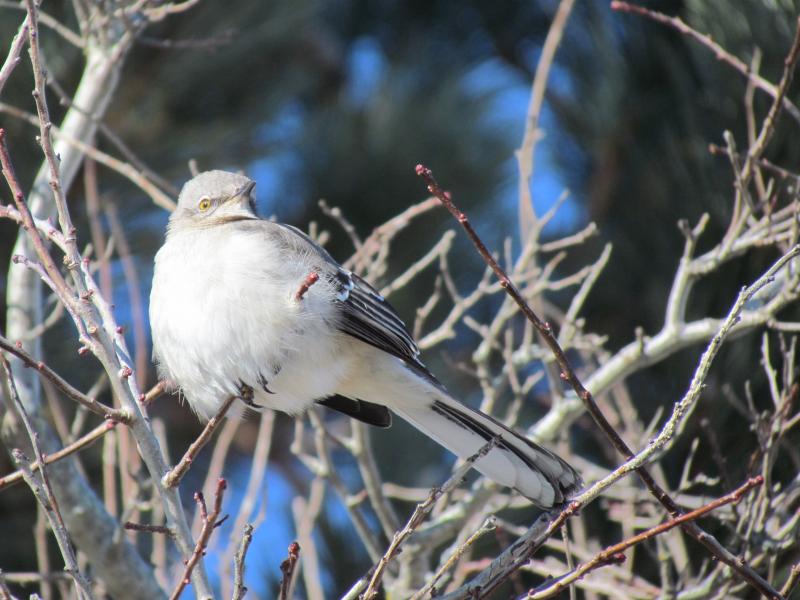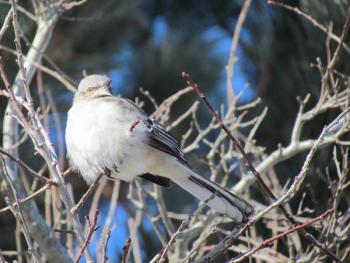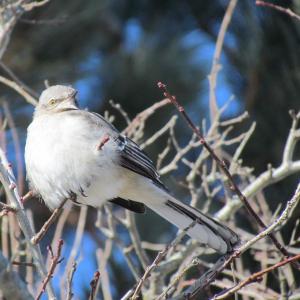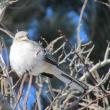The Talented Mr. Mockingbird
As we move into these hot days of summer, the chorus of singing birds begins to change and become less robust. There are still the robins and song sparrows caroling in the morning and the chatter of goldfinches throughout the day. Of course, the red-eyed vireos—“preacher birds,” as we’ve featured in a previous column—will continue singing even when the sun is baking us and every other bird is silent.
Northern mockingbirds are another bird that sings when many other birds have gone silent. Here in Maine, mockingbirds are still somewhat uncommon, although in some parts of southern Maine it is easy to find them in suburban neighborhoods.
We came upon a particularly verbose mockingbird back in June in the cemetery (a place where you can often find them) next to the Augusta airport. This particular individual’s singing ability greatly impressed us. Mockingbirds are well named because they incorporate often seemingly perfect imitations of the sounds of birds and other things into their songs. Some northern mockingbirds have hundreds of different song types. These songs are combinations of their various imitations as well as some sounds specific only to mockingbirds. It is thought that males can demonstrate to females that they are competent and experienced by having lots of imitations in their songs. In theory, this would make them more attractive mates.
The mockingbird we listened to in Augusta cycled quickly through his (females also sing, but given the timing, we guess that this was a male) imitations, repeating some and adding them together in various interesting ways. In the first minute of listening we recognized at least 11 different imitations including a spot-on tree swallow, northern flicker, whip-poor-will, blue jay, killdeer, northern cardinal, barn swallow, American robin, tufted titmouse, eastern phoebe, and gray catbird. At one point he made a vocalization that sounded to us like a police car siren. Before that talented mockingbird was finished, he had added black-capped chickadee, belted kingfisher, broad-winged hawk, and wood thrush into his performance.
It was impressive.
Online readers can hear a couple of minutes of his amazing singing on a recording that we made at the time. We were especially intrigued that he had imitated a whip-poor-will, a species that has become quite rare in most of the state. Could there be whip-poor-wills in the area near the Augusta airport that have gone undetected by us human birders?
The closest relative to the mockingbird in our area is the brown thrasher, a species that also mimics but sings every imitation exactly twice before moving to the next, rather than repeating them many times as does the mockingbird. Oddly enough, while we were listening to and watching the talented mockingbird in the Augusta cemetery, a brown thrasher began singing nearby and eventually flew up beside the mockingbird and displaced it for a time. On our recording you can actually hear the distinctive double-noted song of the brown thrasher take over from the mockingbird at one point. Do mockingbirds and thrashers compete in some way? We don’t know and couldn’t find any research to suggest that they do.
If you find yourself in the vicinity of a singing mockingbird, listen closely, marvel at its amazing abilities, and ponder the mysteries of bird song and behavior.
Jeffrey V. Wells, Ph.D., is a Fellow of the Cornell Lab of Ornithology. Dr. Wells is one of the nation's leading bird experts and conservation biologists, and is author of the “Birder’s Conservation Handbook.” His grandfather, the late John Chase, was a columnist for the Boothbay Register for many years. Allison Childs Wells, formerly of the Cornell Lab of Ornithology, is a senior director at the Natural Resources Council of Maine, a nonprofit membership organization working statewide to protect the nature of Maine. Both are widely published natural history writers and are the authors of the popular books, “Maine’s Favorite Birds” (Tilbury House) and “Birds of Aruba, Bonaire, and Curaçao: A Site and Field Guide,” (Cornell University Press).
Event Date
Address
United States





























